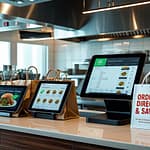Key Takeaways:
- Analyze your P&L statements regularly to identify overlooked costs that could be harming your restaurant’s profitability.
- Pay attention to hidden expenses such as maintenance, licenses, and insurance that may not be prominent in your budget but can significantly eat into your margins.
- Implement a robust budget control system to monitor all expenses, including less obvious ones like waste management or employee turnover.
- Regularly review your supply chain costs; unexpected price increases can impact your bottom line if not quickly identified and addressed.
- Invest in efficient restaurant management software to track daily expenses and highlight any cost anomalies or increases.
7 Overlooked Costs That Are Eating Your Margins
Spot costs you may be missing in your P&L
Managing restaurant finances is a challenging task, especially when hidden costs sneak into your profit and loss statements unnoticed. Even the most experienced restaurant owners can overlook subtle expenses that steadily chip away at profitability. To ensure your establishment thrives, it’s crucial to identify and control these hidden expenses effectively. Let’s explore seven commonly overlooked restaurant costs and how you can regain control over your budget.
1. Food Waste and Spoilage
Food waste is one of the most significant yet frequently ignored restaurant costs. Spoilage, improper storage, and inaccurate portion control can drastically impact your bottom line. According to industry estimates, restaurants can lose up to 10% of their food purchases to waste.
How to Control Food Waste:
- Conduct regular inventory audits to identify spoilage patterns.
- Implement a strict FIFO (First-In, First-Out) system in storage.
- Train staff rigorously on portioning standards and preparation best practices.
- Consider menu design that shares ingredients across multiple dishes to minimize excess.
For example, a New York City bistro realized their food costs were higher than industry standards. After conducting a detailed audit, they found significant losses due to spoilage from improper storage. By retraining staff and implementing better inventory practices, they reduced their food waste by 30%, significantly improving their margins.
2. Credit Card Processing Fees
Credit card processing fees are typically small per transaction but can quickly add up over time. Many restaurant operators accept these fees as unavoidable, failing to realize how significantly they affect profitability.
Managing Credit Card Fees Effectively:
- Regularly shop for competitive merchant processing rates.
- Negotiate with payment processors to reduce transaction fees.
- Encourage customers to pay in cash whenever feasible.
- Analyze monthly statements to spot irregularities or unexpected charges.
One California-based seafood restaurant negotiated their credit card processing fees, saving them nearly $500 monthly without any disruptions to customer service.
3. Staff Turnover and Training Costs
High staff turnover is not only disruptive but also costly. Hiring and training new employees regularly can strain budgets and reduce the efficiency of your operation. These hidden expenses frequently escape notice in standard financial reports.
Reducing Turnover and Training Expenses:
- Create a positive workplace culture that increases employee satisfaction.
- Offer competitive compensation and clear growth opportunities.
- Invest in thorough initial training and ongoing development programs.
- Regularly seek employee feedback to address concerns early.
A Chicago steakhouse struggling with high turnover implemented an employee mentorship program and provided clearer career pathways. Within a year, they reduced turnover by 40%, significantly cutting their training and hiring costs.
4. Utility and Energy Consumption
Energy costs may seem fixed, but careless practices can cause utility bills to rise unnecessarily. Restaurant kitchens use significant amounts of energy for cooking, refrigeration, lighting, and HVAC systems, often more than necessary due to inefficiencies or outdated equipment.
Practical Energy Management Strategies:
- Regularly maintain and clean kitchen equipment to ensure efficiency.
- Switch to energy-efficient appliances and LED lighting.
- Implement schedules to power down equipment when not in use.
- Monitor utility bills closely to quickly identify unusual spikes.
After upgrading to energy-efficient refrigeration units and LED lights, one Florida restaurant significantly lowered their monthly energy bills, recouping the investment within just a year.
5. Untracked Vendor Price Increases
Vendors occasionally implement price hikes that can slip by unnoticed if not actively monitored. Over time, even minor price increases can substantially inflate your expenses, eroding profitability.
Staying Ahead of Vendor Pricing:
- Regularly review vendor invoices and compare against previous periods.
- Negotiate regularly with suppliers for better pricing terms or volume discounts.
- Maintain relationships with multiple vendors to encourage competitive pricing.
- Consider group purchasing organizations to leverage collective buying power.
One Austin-based café discovered incremental vendor price increases had quietly raised their monthly food costs. By renegotiating contracts and switching to alternative suppliers, they reduced their food costs by 15%.
6. Inefficient Inventory Management
Inventory inefficiencies can quietly drain your restaurant’s cash flow. Overstocking results in spoilage and wasted capital, while understocking leads to emergency purchases at higher prices. Both scenarios negatively affect profitability.
Optimizing Your Inventory Management:
- Adopt inventory management software to track stock levels accurately.
- Set clear par levels adjusted regularly based on sales trends.
- Schedule frequent, consistent inventory checks to ensure accuracy.
- Analyze historical sales data to forecast inventory needs accurately.
A Seattle pizzeria implemented inventory software and adjusted their ordering practices based on real-time data, reducing their monthly inventory costs by nearly 20%.
7. Marketing and Advertising Waste
Marketing is essential, but poorly targeted or ineffective advertising drains resources without measurable returns. Many restaurants repeat past campaigns without analyzing their effectiveness, leading to wasted budget.
Maximizing Your Marketing ROI:
- Track the performance of marketing campaigns rigorously.
- Focus on digital marketing channels that allow precise targeting and analytics.
- Avoid costly “shotgun” advertising strategies, opting instead for targeted promotional efforts.
- Regularly review marketing budgets and cut campaigns that don’t deliver clear ROI.
An independent restaurant in Boston shifted their marketing efforts from print ads to targeted social media campaigns. As a result, they significantly increased customer engagement while cutting their marketing spend by 30%.
Conclusion
Identifying and controlling hidden expenses in your restaurant can significantly enhance profitability and financial health. From food waste and credit card fees to training costs and marketing inefficiencies, these overlooked costs accumulate quickly if left unchecked. By actively reviewing expenses, implementing effective management practices, and engaging your team, you can significantly improve your restaurant’s margins and financial sustainability.






Comments
Be the first to comment on this article.